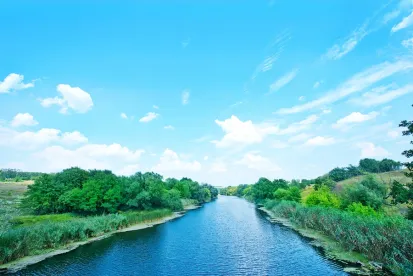On August 13, 2021, the Environmental Protection Agency (“EPA”) reissued the Columbia and Lower Snake Rivers Temperature Total Maximum Daily Load (“2021 TMDL”). The 2021 TMDL is a revised version of a May 18, 2020 temperature TMDL (“2020 TMDL”), for which EPA sought public comment. It is largely similar to the 2020 TMDL, and identifies wasteload allocations for point sources and load allocations for non-point sources (including dam impoundments) that Washington and Oregon will impose through permit conditions. The load and wasteload allocations, once incorporated as permit conditions, are likely to require changes to the operations of point sources and non-point sources, including dams. Changes to the operations of the dams may have widespread impacts on utilities and their customers, as such operational changes are likely to affect power production at the hydroelectric facilities, which provide power to the Pacific Northwest.
Background
Under section 303 of the Clean Water Act (“CWA”), a TMDL specifies the maximum amount of a pollutant that a water body can receive and still meet applicable water quality standards, including water quality standards developed by a state to protect beneficial uses. A TMDL is written as the sum of the individual wasteload allocations for point sources, load allocations for non-point sources and natural background, with a margin of safety.
The Columbia River System is home to several species of salmon and steelhead trout, which are sensitive to fluctuations in temperature. Oregon and Washington established water quality standards to protect beneficial uses—the most sensitive of which are salmon migration and spawning—on the Columbia and Lower Snake Rivers. These two states identified portions of the Columbia and Lower Snake Rivers as impaired because of temperatures that exceeded the numeric criteria of the states’ water quality standards.
In 2020, EPA released the 2020 TMDL for public comment, which examined sources of temperature impairments on the Columbia River, from the Canadian border to the Pacific Ocean, as well as such impairments on the Lower Snake River in Washington, from its confluence with the Clearwater River at the Idaho border to its confluence with the Columbia River.
The 2020 TMDL established temperature targets based on the most protective applicable state water quality standard in each reach, and allocated point sources, non-point sources, and tributaries, a cumulative temperature increase to the mainstem of the rivers of 0.1°C each. It assigned wasteload allocations (expressed as heat loads) to heat discharged from point sources. With respect to dam impoundments on the Columbia and Lower Snake Rivers, which are considered non-point sources, the 2020 TMDL established “load allocations” by modeling how much each dam contributes to the exceedance of the allowable 0.1°C cumulative temperature increase.
The 2021 TMDL
Although EPA received numerous comments on the 2020 TMDL outlining concerns with the modeling and load allocation approach, EPA transmitted the 2021 TMDL to Washington and Oregon for implementation, without significant modifications to the prior version. As with the 2020 TMDL, the 2021 TMDL continues to assign “wasteload allocations” to heat discharged from point sources and “load allocations” to the dam impoundments as non-point sources of temperature pollution. As under the 2020 TMDL, point sources, non-point sources, and tributaries were each allocated a cumulative temperature increase to the mainstem of the rivers of 0.1°C. EPA also maintained its choice of model for determining contributions of the dams to temperature exceedances, despite numerous comments on the inadequacies of the model.
While the 2021 and 2020 TMDLs are very similar, there are several differences, including:
-
EPA acknowledged Tribal temperature standards in the 2021 TMDL, and used those standards to develop target temperatures where they were the most restrictive. In particular, the Spokane Tribal criterion was used for September-October at Lake Roosevelt RM 639. Under that standard, the dam allocation at this location is zero impact.
-
Whereas the 2020 TMDL indicated that the range of current source impacts on the Lower Snake River mainstem from June to October from the dams was 0.3°C to 3.2°C, the 2021 TMDL recognized that the change caused by the dams may be negative (identifying a range of -0.2°C to 3.2°C). Nevertheless, EPA still concluded that temperature impacts from the impoundments were the most substantial contributor to temperature exceedances and that it is equitable to call for greater reductions from these sources.
-
EPA determined that Banks Lake water withdrawals impact the temperature of the Columbia River by decreasing river flow in the Summer. EPA determined that reducing these water withdrawals would improve instream temperatures and could be considered as a management measure during TMDL implementation.
-
EPA explicitly stated that the TMDL target temperatures apply at all locations within the mainstem Columbia and Snake Rivers. This includes not only the target sites (dam tailraces) but also areas such as fish ladders, dam forebays, surface waters in impoundments, and nearshore zones.
Implications
The 2021 TMDL has significant implications for hydropower as well as traditional point sources of pollutants. Implementation of the TMDL is the responsibility of Oregon and Washington. Point source discharges are subject to National Pollutant Discharge Elimination System (“NPDES”), and the wasteload allocations for point sources as set forth in the 2021 TMDL will be incorporated into and enforced through NPDES permits.
Although EPA lacks authority to implement non-point source controls or otherwise assure reductions in nonpoint source temperature pollution, load allocations for the dams will become conditions of water quality certifications issued by the states in connection with other federal permits. The eight Army Corps of Engineers’ dams in the lower Columbia and Lower Snake Rivers have sought NPDES permits for their point source discharges of oils, greases, and lubricants. Those NPDES permits require water quality certifications from the State of Washington. Although temperature impacts are unrelated to the point source discharges for which the federal dams sought NPDES permits, Washington included conditions in the water quality certifications that require the dams to meet load allocations in the 2021 TMDL. Those water quality certifications are subject to an ongoing appeal before the Washington Pollution Control Hearings Board (“PCHB”); however, the PCHB already determined that Washington acted within its authority when imposing the conditions related to the TMDL.
The 2021 TMDL could also impact non-federal dams. As with the federal dams, non-federal dams may be required to obtain NPDES permits for discharges of oils, greases, and lubricants. Such permits require water quality certifications from the state. Moreover, non-federal dams on the Columbia and Lower Snake Rivers are subject to Federal Energy Regulatory Commission licensing requirements. When those dams go through the relicensing process, they will again be required to seek a water quality certification from the state. The state is likely to impose requirements on the dam impoundments to meet the load allocations as part of the water quality certification process.
It is not clear whether the load allocations for the federal dam impoundments could be achieved by changing the spill rate, or whether the only way to achieve the load allocations would be through removal of the dams—an action being debated for the Snake River dams. Hydroelectric facilities are a significant source of power to the Pacific Northwest. Fundamental changes in dam operations or their potential removal would affect power production at hydroelectric facilities and in turn may have widespread impacts on utilities and their customers.
The EPA is currently not accepting any comments on the 2021 TMDL but legal challenges could still take place.





 />i
/>i


